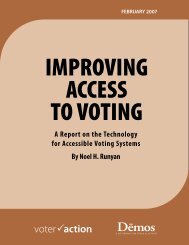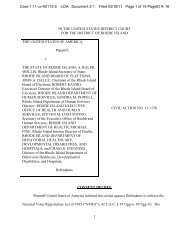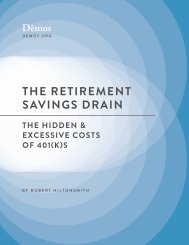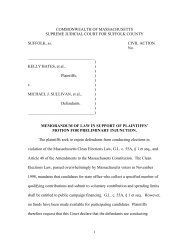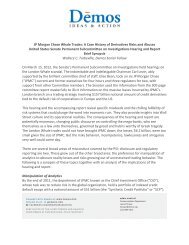Philip Harvey - Demos
Philip Harvey - Demos
Philip Harvey - Demos
You also want an ePaper? Increase the reach of your titles
YUMPU automatically turns print PDFs into web optimized ePapers that Google loves.
THE ADVANTAGES OF DIRECT PUBLIC JOBS<br />
It’s Cost-Eective<br />
A comparison of three dierent stimulus approaches illustrates the power of the direct<br />
job-creation strategy. e two stimulus methods most recently enacted were tax cuts and<br />
extended benets programs like unemployment insurance and food stamps. $100 billion<br />
spent on tax cuts would indirectly generate 136,000 full time jobs within two years,<br />
while $100 billion spent on benets would indirectly generate 714,000.<br />
NUMBER OF FULL-TIME JOBS CREATED<br />
JOB CREATION EFFECT OF A TWO YEAR<br />
$100 BILLION FISCAL STIMULUS<br />
4000000<br />
3500000<br />
3000000<br />
2500000<br />
2000000<br />
1500000<br />
2 Back to Work: A Public Jobs Proposal for Economic Recovery<br />
e third option -- $100<br />
billion spent to directly hire<br />
Americans workers – would<br />
create 2.6 million fulltime<br />
jobs over two years:<br />
2.1 million directly and<br />
an additional half million<br />
indirectly.<br />
It is important to note that the<br />
failure to provide jobs for people<br />
who want them isn’t cheap<br />
either. e Great Recession<br />
was responsible for nearly twothirds<br />
of the 2009 decit. 4<br />
Accordingly, aggressive action<br />
to lower unemployment will<br />
be the most eective, fair and<br />
sustainable way to close the<br />
decit: for every million unemployed Americans who goes back to work, the decit falls by<br />
$54 billion. 5<br />
1000000<br />
500000<br />
0<br />
TWO YEARS<br />
FOUR YEARS<br />
YEARS OF STIMULUS<br />
BUSH TAX CUTS<br />
UI AND SNAP BENEFITS<br />
DIRECT JOBS PROPOSAL<br />
2. It Puts Americans Back to Work Now<br />
Public jobs have “time value” because they are jobs created immediately. Tax cuts,<br />
benets payments and other indirect stimulus approaches do not start “working” on job<br />
creation immediately; they require the recipients to spend the money at their discretion,<br />
which eventually aggregates to increase overall demand in the economy. is in turn<br />
results in businesses hiring workers in order to meet the increased demand. Economists<br />
often use the term “time value” with regards to money to explain why people are willing<br />
to pay interest to borrow it. e time value of money is nothing compared to the time<br />
value of jobs during a recession. Measured in the currency of human well-being, every<br />
job created for an unemployed worker during a recessionary contraction is worth far<br />
more than the same job created two years later. By then, a house may have been lost. A<br />
marriage may have failed. A child may have been traumatized in ways that will resonate<br />
throughout his or her life.




